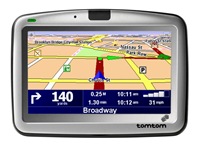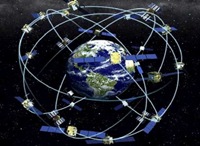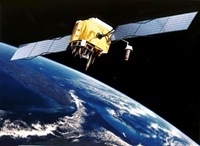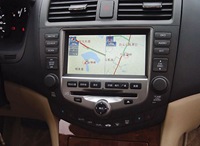GPS is amazing technology. It’s also amazingly creepy technology. It’s a weird thing, having a satellite somewhere in space following your every move, allowing you to pinpoint your exact position on the globe within a few feet. It’s strange being “watched” by something you cannot see. Despite that, there is an undeniable usefulness in GPS, which has transformed the way people get around. These days it’s almost impossible to get lost, as GPS serves as a constant companion that always knows the way to your destination. Travelers are never again alone – and not only can they find their way, but they can get information on places they may want to stop en route, their speed of travel, and the time. There is a strong sense of comfort in having a GPS system when in an unfamiliar area, since nothing is unfamiliar to it.
In our car dashboards, in stand-alone handheld units and in our cell phones, GPS receivers come in all shapes and forms. All a person needs is an unobstructed view of space and their receiver of choice to do away with nearly every previous method of directional navigation. Put away your map and forget that sack of bread crumbs.
The big question – how does it work? How does your GPS receiver know where you are? How is it so accurate? What is making it function? Today we’ll take a simple look at GPS receivers and what makes them work to understand how these fancy little units make travel so easy.
GPS, or Global Positioning Satellite, is a technology that came out of the 1970s as an effort to develop a system for detecting ballistic missile submarines. They conceived a system that would not be impacted by weather, could not be jammed and had infinite range. It was built in the 1980s, and first moved to the public sector in the 1990s.
The result is what we have today: 24 earth-orbiting satellites that are now open to public use for GPS purposes. There are actually 27 of them, but three of them just hang out and aren’t used – unless one of the other 24 fails. They are all owned by the United States. While all these space-based satellites obviously involve some massive complicated technology that goes beyond the scientific and financial comprehension of most people, the fundamental methods by which GPS satellites function in relation to receivers is relatively simple.
Each GPS satellite is out there at a distance of 11,000-12,000 miles (different sources cite different exact distances), weighs two tons, is a little over 18 feet long and orbits the earth in 12 hours. Their positioning is designed so that at any given time, there are at least four satellites available to any particular location.
GPS receivers require you to be outside. Sometimes, even exterior factors can block GPS signal, like super tall trees in the forest or standing near skyscrapers. It does, however, work all around the world, 24/7, in all weather, with no subscription fee.
Every GPS satellite transmits data about its current position and the current time. The time is controlled by the atomic clock and the position is based on where the satellite is in its rotation. All 24 of the GPS satellites are synchronized, so they all transmit this information at the same time. This all moves to your receiver at the speed of light.
With all that information, we come to the basic function of the GPS receiver: to locate as many satellites as it can at the time and figure out the distance between itself and the satellites. It uses this information and a process called trilateration to determine its own location. The more satellites it can connect to, the more precise its self-positioning will be.
Trilateration is quite a word. Just saying it would be meaningless without a little explanation. It is a process of deduction. I’ll use the familiar city-based example method for explaining the basic process of how the receiver translates distances to satellites into your own location:
Say I tell you you’re 370 miles from New York City. That’s useless, because you could be 370 miles in any direction. But then say I tell you you’re 130 miles from Cleveland, Ohio. This is a little more helpful, because now you at least know you’re somewhere between Cleveland and New York. It helps establish a direction, but still isn’t very specific. Then say I tell you you’re 230 miles from Charleston, West Virginia. If you drew a line out from all these cities and their appropriate distances on a map, they’d all intersect at one place – Pittsburgh. That’s very basic trilateration. A GPS receiver works similarly, taking the distances between the satellites that are orbiting the earth at different angles to trilaterate and figure out its own position. This is why when you can access more satellites, you can get a more specific positioning. Read on to see exactly how your GPS receiver determines its distance from the satellites.
GPS receivers range in price for a variety of reasons. One of which is the number of receivers within the unit. Better units have several, which allow them to pick up more satellite signals simultaneously. Because not all the satellites are the same distance away, the signals don’t hit the receivers all at the exact same moment. Better units can handle this easier by utilizing multiple receivers.
Radio waves handle the communication. Radio waves are super quick, moving at about 186,000 miles per second. The satellites aren’t even 1/10th of that distance from Earth. But, because the receiver has a super scientific computer brain, it is able to determine the satellite’s distance by clocking how long it took the signal to arrive. Measuring distance with time – how classy! It’s actually pretty complicated. Get ready, more explanation is necessary… I’ll keep it simple.
Satellites emit a code. Your receiver emits the same code at the same time. The code emitted by the satellite is nabbed by the receiver and compared to its own code. There will be some lag, because the signal from the satellite took time to arrive from space. The receiver multiplies the lag by the speed of light to determine its travel time, and thus the distance the satellite is from the receiver. Got it? Good. No? Read it again.
Another thing the receiver does is store information about where all the satellites should be at any given time. They do move in fairly set patterns, after all. If any changes are made to the satellites’ orbits, the Department of Defense updates the information which gets sent to your GPS receiver.
Of course, all of this doesn’t always work out so peachy keen. Nothing is perfect, believe it or not, not even space-to-palm radio communications! Fortunately, your GPS receiver is handy at fixing problems and fixing errors. Most handheld GPS units have a 10-20 meter accuracy, which is due to little bits of calculation error that make things slightly less than exact. This is where one of the other factors that change GPS cost come into play. Better receivers have differential compensation technology that can fine-tune that accuracy down to as little as three meters.
Interference in the radio signal, slow-down as it passes through the atmosphere, bad information and other problems can cause the data to be faulty. Oh thank heaven for differential GPS.
Differential GPS uses a stationary receiver station to correct inaccuracies from the rover units in space. The system knows where it’s located, and it doesn’t move. If your receiver has DGPS capability, it can receive information from these systems, which will provide signal correction information to your unit. This increases accuracy because of the communication with a fixed-point signal.
There is also Wide Area Augmentation Systems (WAAS), which do a similar thing. It is a product of the Federal Aviation Administration that uses networked ground-based reference stations in North America and Hawaii to send correction messages to GPS receiver units. These correction technologies are something that could deserve its own article, and perhaps someday we’ll look at it in-depth.
Once all of the above information is received, calculated and corrected, your GPS receiver is able to figure out its latitude and longitude on the earth. This is crucial, because this is the information that allows your receiver to create a visual map display that is the heart of the device. What good would GPS information be if you couldn’t see it on the map?
Your receiver is in unending communication with the orbiting satellites. Of course, everything we’ve talked about so far happens in the blink of an eye, thousands of times per second. Your GPS receiver can use this constant flow of data to give you turn-by-turn instructions on the road, visual representation of your position on the map, and it can even judge things like your travel speed and travel time. Constant communication = constant information = constant calculation = a fluid stream of data that appears on your screen.
The GPS unit is able to figure out driving routes for you based on the maps stored within its system. The basic rule of travel is that the shortest distance between two points is a straight line. Of course, roads don’t travel in straight lines, but your GPS is programmed to determine the most direct route between your latitude and longitude and the latitude and longitude of where you want to be using that concept. It picks the roads that get you there with the least amount of winding, allow the quickest driving speeds and all that jazz – just like directions given by any other computer system like Google Maps or MapQuest. Once the positioning data is in your GPS receiver, it’s the job of the software to calculate the route.
Conclusion:
Those 24 satellites handle all GPS positioning in the world. From the UPS guy to some random family on their way to Georgia, everyone is finding their way much easier thanks to GPS technology.
Hopefully now you understand a little better how satellites 11,000 miles away can pinpoint your location within a few feet. It’s an amazing process that has revolutionized travel and changed the way we interact with foreign areas. Seeya next week for another installment of how something works.






2 comments for “How Stuff Works: GPS Receivers”